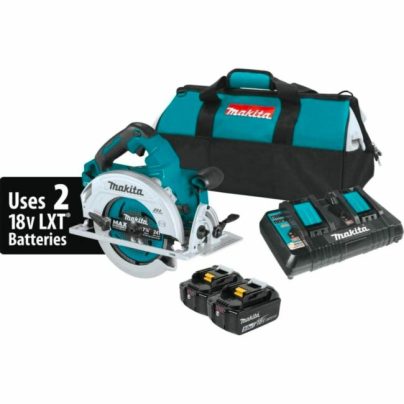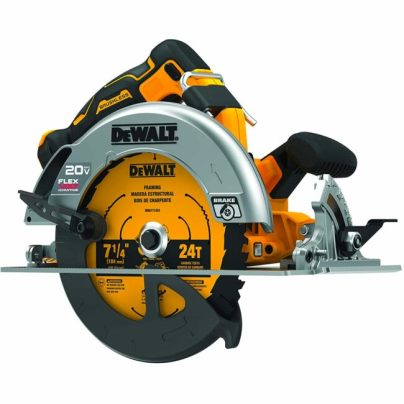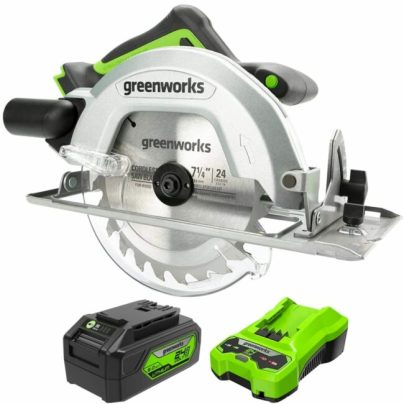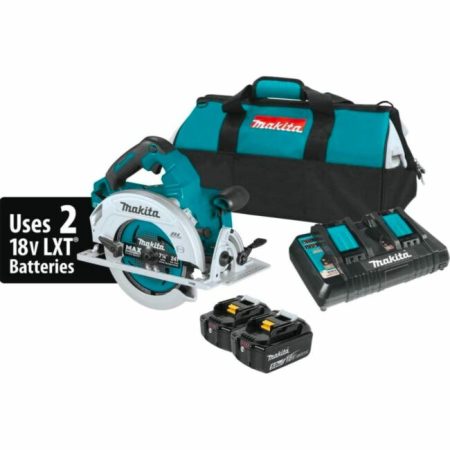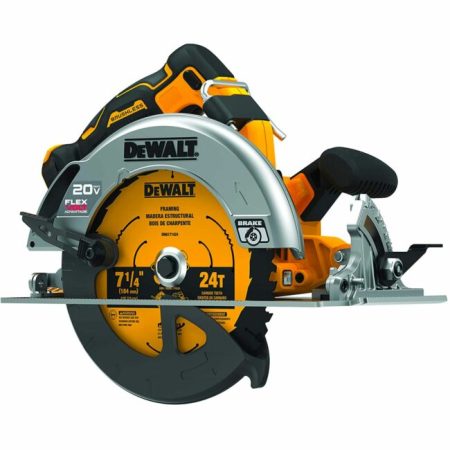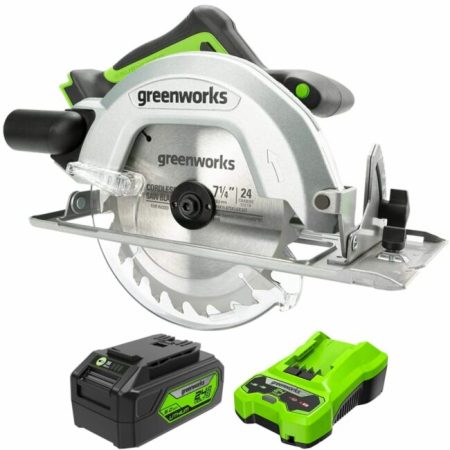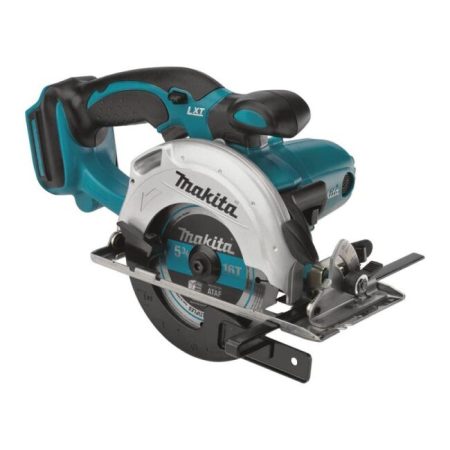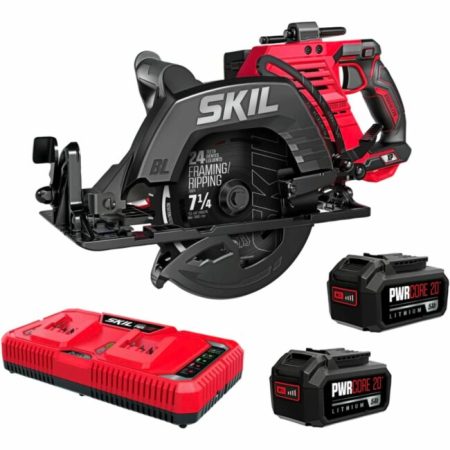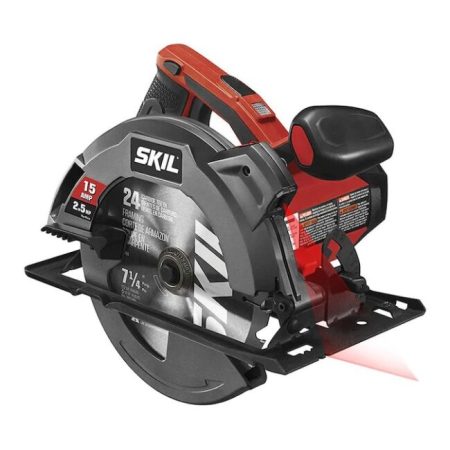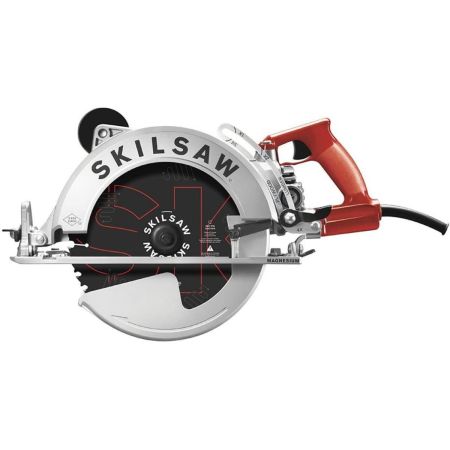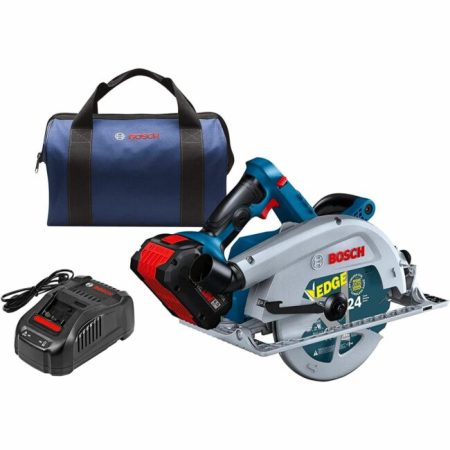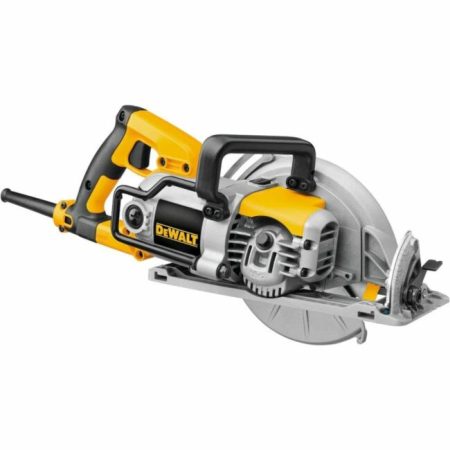We may earn revenue from the products available on this page and participate in affiliate programs. Learn More ›
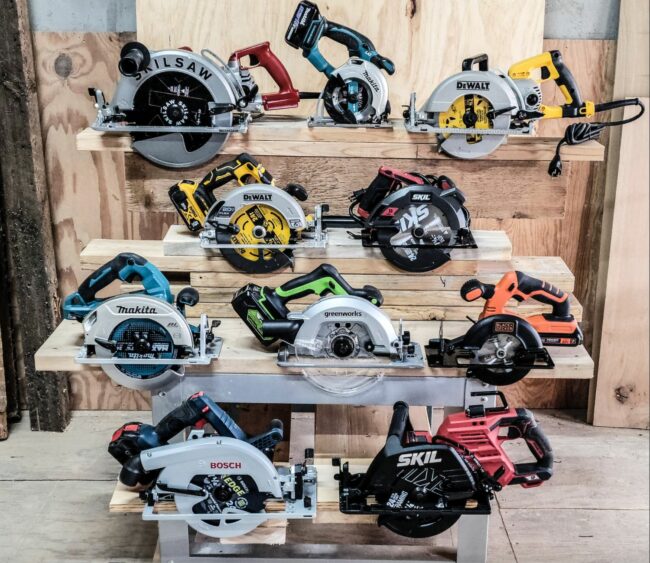
The words “versatile” and “tool” are combined so often these days that it’s hard to tell if it’s the truth or just a marketing ploy. But a quick tour of a professional construction site will undoubtedly prove that a circular saw—a handheld electric saw that uses a round spinning blade to cut materials—is the real deal when it comes to versatility. A good home workshop also warrants a reliable, powerful saw for various tasks, from breaking down a sheet of plywood to making quick, repetitive cuts on a stack of framing lumber.
Almost every power tool company sells one or more circular saw models. With an abundance of brands, power options, and features, choosing one can be challenging. We decided to test today’s most popular options and determine which ones were up to the task of making powerful, consistent cuts.
We tested the saws on various wood types, including timbers, particle-strand lumber (PSL), plywood, and dimensional lumber. We didn’t go easy on them because these tools should be capable of delivering reliable results even when pushed to their limits. The following lineup of the best circular saws features the ones that excelled in our tests. Find out the pros, cons, and maybe a few surprises we discovered when testing these top tools.
- BEST OVERALL: Makita XSH06PT 36V Brushless 7¼-Inch Circular Saw Kit
- RUNNER-UP: DeWalt DCS573B 20V MAX Cordless 7¼-Inch Circular Saw
- BEST BANG FOR THE BUCK: Greenworks 24V Brushless 7¼-In. Circular Saw
- BEST SMALL: Makita XSS03Z 18V LXT Cordless 5⅜-Inch Circular Saw
- BEST FOR FRAMING: Skil CR5429B-20 PWR CORE 20 7¼-Inch Circular Saw
- BEST LASER GUIDE: Skil 5280-01 Corded 7¼-Inch Circular Saw
- BEST FOR TIMBERS: Skil SPT70WM-01 10¼-Inch Worm Drive Circular Saw
- BEST KIT: Bosch Profactor 18V 7¼-Inch Circular Saw Kit
- BEST FOR PROS: DeWalt DWS535B 7¼-Inch Worm Drive Circular Saw
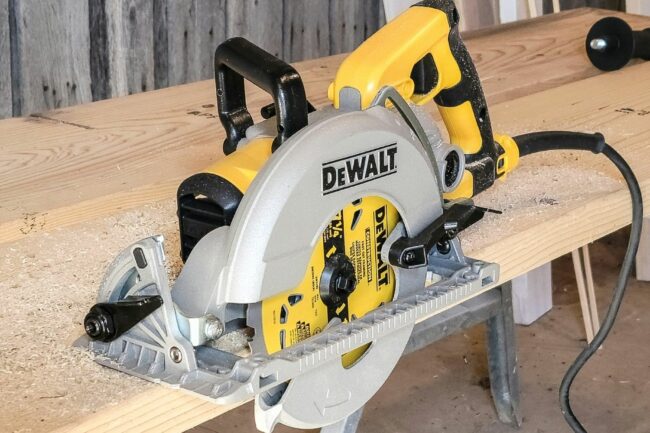
How We Tested the Best Circular Saws
Putting together a list of the circular saws was more fun than work. After all, if there’s one tool we’re not short on experience with, it’s circular saws. We drew upon our past experience with these tools to help us decide which models to test.
First, we thought about all the must-have features we can’t live without and compiled a large pool of tools (more than 25!). Then, we narrowed them down by the brands we know and trust, as not all manufacturers offer the same quality.
Our hands-on testing involved using each saw to cut materials repeatedly for an hour with each circular saw. We made both angled and straight cuts during each saw’s test period and noted how well the tool performed the tasks. We only cut the materials suggested for the saws; for example, we did not attempt to cut LVLs, which are very dense and difficult to cut with compact circular saws that are not made to withstand that type of cutting. Likewise, we didn’t bother cutting plywood with the oversize worm-drive saw, which is explicitly designed to cut denser, thicker materials such as timbers.
We closely monitored each circular saw throughout the test period to determine whether it heated up (a sign the motor isn’t keeping up with the cutting). We also noted how easy/challenging it was to adjust each tool’s blade angle and cutting depth. Most of today’s manufacturers are now putting quick-change lever adjustments on their saws, but some still require a wrench to make these adjustments.
During each test, the saws were awarded points using a rubric. The better they performed, the higher the points they earned. After testing, we added and averaged the scores to determine each saw’s best use.
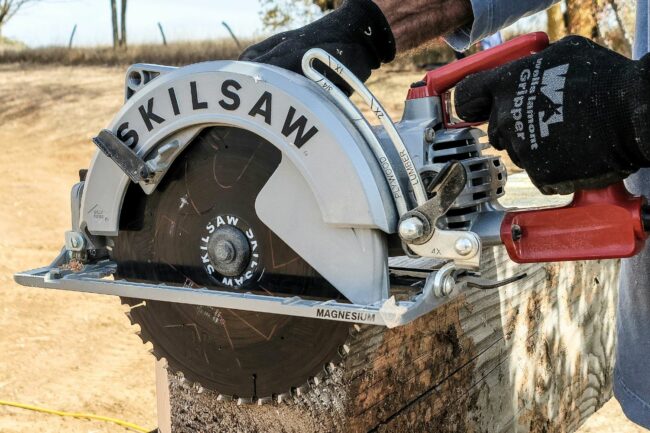
Our Top Picks
When choosing the best circular saw, there is a lot to know. Luckily, shopping for one doesn’t have to be so confusing. Our hands-on testing process put these tools to work, making straight and angled cuts on various types of material. Unfortunately, not all the saws we tested met our high standards. You can find the ones that didn’t measure up detailed under “Also Tested.” The following models all excelled to earn a spot on this list of the best circular saws, and one is sure to be suitable for a particular user’s project.
Best Overall
Makita XSH06PT 36V Brushless 7¼-Inch Circular Saw Kit
See ItProduct Specs
- Power source: Lithium-ion cordless battery
- Speed: 6,000 rpm
- Model: XSH06PT
Pros
- High-quality magnesium foot plate and blade guard add to durability
- Quick lever adjustments for the blade depth and angle make adjustments fast and simple
- 2 bright guide lights illuminate the material right at the point the saw meets the blade
Cons
- Sawdust discharge port didn’t do a great job keeping sawdust out of the air when a vacuum hose was attached
For several reasons, the 36-volt cordless Makita circular saw takes top honors in our lineup of the best circular saws. One of the first things we noticed was that the flat base, or “shoe,” was made from magnesium, and so was the retractable blade guard—we were impressed. In our experience, magnesium is not only lightweight, it’s also more durable than steel or aluminum.
We charged both 18-volt lithium-ion batteries to full capacity and got started. We put the Makita to the test by making straight and bevel cuts of various depths on plywood and dimensional lumber. It powered through smoothly with no torque loss, even after the battery indicators showed less than half a charge. We made repeated cuts over an hour, and the Makita’s motor and housing never heated up.
The saw comes with a quick-change angle adjustment, which is handy and straightforward. The Makita cuts at any angle up to 56 degrees and has positive stops, meaning the angle adjustment clicks into a locked position at standard cutting angles of 22½, 45, and 56 degrees. It cuts to a maximum 2⅝-inch depth, and adjusting the depth was a breeze. The easy adjustments make this saw well-suited for quick-moving projects when the user needs to change angles or depth quickly and doesn’t want to stop and use a wrench (the old-fashioned way) to make the adjustments.
This top-performing circular saw also comes with a sawdust discharge nozzle. Typically, these nozzles help direct the flow of sawdust in outdoor settings, but they’re also made to connect to standard wet/dry vacuum hoses. We noticed quite a bit of sawdust escaping from around the blade guard rather than discharging out of the nozzle, so we felt it didn’t make much difference.
Read our full review:Makita 36V (18V X2) Brushless 7¼-In. Circular Saw KitGet the Makita 36V circular saw at Amazon, The Home Depot, or Acme Tools.
Runner-Up
DeWalt DCS573B 20V MAX Cordless 7¼-Inch Circular Saw
See ItProduct Specs
- Power source: Cordless electric
- Speed: 5,500 rpm
- Model: DCS573B
Pros
- Relatively compact and ergonomic design makes it suitable for carrying on the job site
- Rafter hook allows user to hang the tool securely when working at heights rather than set it down where it could fall
- Blade depth and angle are easy to change with quick-adjust levers
Cons
- Base shoe is made from aluminum rather than magnesium
DeWalt is a leader in the power tool market, and this 20-volt cordless circular saw is a perfect example of why. This saw excelled in our testing, proving to be well-designed and ergonomic—a great combination. We made repeated straight and angled cuts of various depths over an hour and the saw didn’t lose power or heat up. It had just as much power on its last cut of the test as its first.
This circular saw from DeWalt has a bevel capacity of up to 57 degrees, with positive stops at 45 and 22½ degrees, making it handy to cut standard angles without needing to examine the angle measurements carefully before locking in. At 2 9/16 inches, it also offers a deeper cutting depth than most of its competitors.
The base is aluminum, which makes the tool relatively lightweight (9 pounds). We would have preferred a magnesium base for durability purposes, but we don’t consider the lack to be a deal breaker. We found both the blade-angle-adjustment lever and the depth-adjustment lever saved time when we made adjustments.
This DeWalt also boasts a rafter hook, which adds to its versatility. Given this is a slightly compact saw, the rafter hook makes it a top option for framing a roof structure with dimensional lumber—users can hang it on a rafter while performing another task and then grab it when they’re ready to cut again. We like this DeWalt saw for pros, but we also think dedicated DIYers will use it a lot.
Get the DeWalt 20V circular saw at Amazon, The Home Depot, or Acme Tools.
Best Bang for the Buck
Greenworks 24V Brushless 7¼-In. Circular Saw
See ItProduct Specs
- Power source: Lithium-ion battery
- Speed: 4,500 rpm
- Model: CR24L00K
Pros
- An affordable circular saw that is suitable for making most DIY and around-the-house cuts
- Comes with a battery charger and a lithium-ion battery; ready to cut right out of the box
- Nice ergonomics; feels comfortable in hand during use
Cons
- Offers slightly less speed than some other models
- Blade guard is made from plastic rather than metal, which puts it at greater risk of breaking
Not everyone needs all of the features of a top-of-the-line cordless saw or the heavy-duty capability of a timber-framing model. For DIY projects that include an occasional small framing job or breaking down plywood sheets—especially when saving money is a priority—the affordable Greenworks 7¼-Inch Circular Saw might be the right choice.
We’ve tested plenty of tools from many manufacturers, but this is the first Greenworks power tool we tried, and we were pleasantly surprised. Despite its affordable price, this circular saw made repeated straight and bevel cuts in plywood and dimensional lumber over an hour of solid testing, without heating up on us or losing power. It tops out at 4,500 rpm, which is slightly less speed than some of the other saws we tested, but it was sufficient for cutting the types of wood most DIYers will need to cut.
The CR24L00K features quick adjustments for both angle cutting (up to 45 degrees) and cutting depth (up to 2½ inches), and we found it simple to adjust both. The base shoe is made from stamped metal, which is to be expected at this price point, but we were disappointed that the blade guard is plastic—it really should be metal. The blade guard didn’t break during our tests, but it’s a weak point in the tool’s design.
Get the Greenworks circular saw at Amazon, Lowe’s (without battery), or Greenworks.
Best Small
Makita XSS03Z 18V LXT Cordless 5⅜-Inch Circular Saw
See ItProduct Specs
- Power source: 18V lithium-ion battery
- Speed: 3,600 rpm
- Model: XSS03Z
Pros
- Lightweight at under 7 pounds; suitable for overhead cutting when necessary
- Although compact, still offers a 2-inch depth of cut, which increases versatility
- Size plus cordless operation makes this a worthy portable option
Cons
- Dual hand support is on the small side and not well suited to large hands
- A “tool only” purchase—the battery and charger must be bought separately
For part-time DIYers or smaller-framed users, Makita’s 18V LXT cordless 5⅜-inch circular saw’s small size and minimal weight make it an attractive, portable option. This saw weighs just 6 pounds, allowing DIYers of any size and skill level to wield it.
Despite its minimal size and small blade, this cordless circular saw has a depth of cut of up to 2 inches, offering more than enough capacity for cutting dimensional lumber. Its 3,600-rpm top speed ought to make it capable of handling most projects, though the speed is less than some competitive models. The base bevels up to 50 degrees to allow users to make angled cuts.
Although small, we found that this Makita packs quite a punch. We tested it by cutting plywood and dimensional lumber, making straight cuts and angles, and it powered right through. The dual support knob is a little on the small side, but we were able to use it to keep the saw stable while cutting. We think most pros will use this compact saw as a one-handed saw, however, and not depend on the dual support. This saw is well suited for light cutting and overhead cutting, where it isn’t easy to wield a heavier circular saw.
Get the Makita 18V circular saw at Amazon or Acme Tools.
Best for Framing
Skil CR5429B-20 PWR CORE 20 7¼-Inch Circular Saw
See ItProduct Specs
- Power source: Two 20-volt lithium-ion batteries
- Speed: 5,300 rpm
- Model: CR5429B-20
Pros
- Elongated design of the saw adds control and stability during cuts
- Two 20-volt batteries, included with purchase, provide twice as much power
- While still a 7¼-inch circular saw, it can be adjusted to a depth of 2 9/16 inches, which is deeper than most 7¼-inch saws
Cons
- Must push a second button to adjust the angle past 45 degrees, which is cumbersome and slows down angle adjustment
Those who want a pro-level circular saw for DIY jobs should consider this Skil model. At first glance, we thought the Skil PWR CORE was a worm-drive saw because of its length and heft. It’s a sidewinder, however, with the motor located next to the blade—not behind it. When inspecting the saw, we discovered that the additional length was the positioning of the double-battery case, which sits to the rear of the motor.
By grasping the rear handle and the dual stabilizer bar at the front, we could easily control the saw when cutting dense wood and larger pieces of dimensional lumber. The two 20-volt batteries (5 amp hours or Ah), which are included, provided more than enough power to make repetitive straight and angled cuts on plywood and dimensional lumber. Since it’s billed as a heavy-duty model, we also tested it on laminated veneer lumber (LVL), which is very dense and more difficult to cut than dimensional lumber. The saw cut through the LVL without bogging down.
We like the deeper-than-average cutting depth of 2 9/16 inches and the up to 53-degree-angle cutting capacity. What we didn’t like was having to press a second lever to adjust the blade angle beyond 53 degrees. The Skil saw has a lock stop at 45 degrees, and we had to push a separate latch to adjust the angle farther, which felt uncomfortable and seemed unnecessary. We also would have preferred a magnesium base shoe to the aluminum one, but we did like the elongated shoe style that helps stabilize the saw on deep cuts.
Overall, we found this saw to be well-designed, ergonomic, and suitable for heavy-duty DIY use. This is the Skil model that we feel bridges the gap between a standard consumer and a pro tool.
Get the Skil PWR CORE circular saw at Amazon, Lowe’s, or Acme Tools.
Best Laser Guide
Skil 5280-01 Corded 7¼-Inch Circular Saw
See ItProduct Specs
- Power source: Corded 15-amp motor
- Speed: 5,300 rpm
- Model: 5280-01
Pros
- Corded saw will never run out of power as long as an outlet is nearby
- Laser guide is bright and strong; we could see it when cutting outdoors on a sunny day
- Boasts impressive speed (5,300 rpm) for a saw at this price point
Cons
- Several components, including the retractable blade guard, are plastic
- Being corded saves on cost but restricts the portability of the saw
Getting the hang of a circular saw can be challenging, but a circular saw with laser guidance can make jobs much easier. This Skil circular saw features a single-beam laser that allows the user to maintain consistent passes on cutlines, taking some of the learning curve out of straight cuts.
In our experience, some laser guides are dim, or they don’t extend more than a few inches, but the laser on the Skil saw is a notable exception. Even outdoors on a mostly sunny day, the laser was visible on the material for more than 2 feet.
This saw cuts angles up to 51 degrees and comes with a positive stop at 45 degrees, which is the angle used most often when
. Adjusting both angle and depth is simple via levers, and the tool comes with a maximum cutting depth of 2.4357 inches.
Besides the laser beam, this corded circular saw also boasts a 5,300-rpm top speed from its 15-amp motor, offering plenty of power and capability. The saw did get pretty warm to the touch after about 45 minutes of use, which told us that we were pushing it further than it was designed to go. While we deem it a good choice for making straight and angled cuts on plywood and dimensional lumber, it’s not for heavy-duty sawing. It has several plastic components, which likely helps keep the price down, so we consider it to be best for novice DIYers who work on small projects and need the addition of a bright laser guide when cutting.
Get the Skil 15-Amp circular saw at Amazon or Lowe’s.
Best for Timbers
Skil SPT70WM-01 10¼-Inch Worm Drive Circular Saw
See ItProduct Specs
- Power source: Corded 15-amp motor
- Speed: 4,700 rpm
- Model: SPT70WM-01
Pros
- Plenty of cut capacity for lumber and thick timbers thanks to worm-driving gearing that provides maximum torque
- Comes with a magnesium base shoe for long-lasting durability and cutting stability
- Ability to make deeper cuts of up to almost 4 inches; perfect for dense wood varieties
Cons
- At 16.6 pounds, a heavy saw that can quickly lead to arm, hand, and shoulder fatigue
Here comes a real big boy! Believe it or not, Skil’s Magnesium Worm Drive Skilsaw isn’t its largest offering—it’s a midsize model at 10¼ inches. This worm-drive saw can cut framing materials and sheet goods and handle thick timbers associated with post-and-beam and timber framing.
Like most of today’s worm-drive saws, this model is corded because it’s simply too big and has too much torque to run on most lithium-ion batteries. We plugged it into a 12-gauge exterior extension cord and started testing. We made various straight and angled cuts on dimensional lumber and an LVL. We didn’t bother cutting plywood because this saw is meant for bigger things. Instead, we used it to bevel the edge of a large 8-foot-long 12-inch by 12-inch Hem-Fir beam, and it performed flawlessly. The saw has an enviable cutting depth of 3 11/16 inches, and it cuts angles up to 51 degrees. Both the blade angle and depth are easy to adjust via levers. We made repeated cuts in an hour’s time, and the saw didn’t warm up at all.
The saw’s top speed is 4,700 rpm, which is slower than some saws we tested. But its real benefit lies in its high torque that keeps the blade spinning through thick and dense materials. Weighing in at 16.5 pounds, this is a monster of a saw, and it may be a bit much for some DIYers. Still, for those who need to cut sizable dimensional lumber or timbers, it’s a slam dunk.
Get the Skil Worm Drive circular saw at Amazon, Acme Tools, or CPO.
Best Kit
Bosch Profactor 18V 7¼-Inch Circular Saw Kit
See ItProduct Specs
- Power source: Cordless, lithium-ion battery
- Speed: 5,000 rpm
- Model: GKS18V-25CB14
Pros
- Good ergonomics; nonslip grip helps the user keep a firm grasp
- Adjusting the blade angle and the cutting depth is easy with quick-change levers
- Includes a battery, charger, and bag to store all components
Cons
- A fairly pricey pick for a circular saw
- At 12 pounds, 1 to 3 pounds heavier than competing models
We’ve purchased “tool-only” power tools in the past, only to find we had to pay as much or more for a rechargeable battery and charger. The Bosch Profactor circular saw gets around that issue by including all three in this circular saw kit. It also comes with a heavy-duty canvas bag for keeping all the components together.
We charged the battery and started testing. The Bosch boasts easy-to-change blade angle and depth adjustments—it cuts angles up to 50 degrees and features a 2½-inch maximum cutting depth. Though the base shoe and blade guard are aluminum, it’s a well-built saw that, at 12 pounds, weighs slightly more than some of the similar 7¼-inch models we tested.
We made multiple straight and angled cuts through dimensional lumber and plywood without a hitch. The Bosch saw didn’t overheat—even with near-constant use over an hour.
Interestingly, the blade on this model is on the left, whereas the blades on most 7¼-inch circular saws are on the right. However, while this took a little getting used to, we didn’t feel it was a downside—the saw can be used easily by a right-handed or left-handed user.
Get the Bosch circular saw at Amazon, Lowe’s, or Acme Tools.
Best for Pros
DeWalt DWS535B 7¼-Inch Worm Drive Circular Saw
See ItProduct Specs
- Power source: Corded, electric
- Speed: 4,800 rpm
- Model: DWS535B
Pros
- For a worm drive saw, model is pleasantly light at less than 9 pounds
- Design is ergonomic and easy to control using 2 hands
- Features high-quality materials, including a magnesium base shoe and aluminum blade guard
Cons
- At just 2.438 inches, it comes with a slightly shallower cutting depth compared to other 7¼-inch non-worm-drive competitors
DeWalt is well known for producing high-quality power tools, and the DWS535B is no exception. We really liked the fact that DeWalt put a magnesium base shoe on this model and used lightweight aluminum for the blade guard. It isn’t as heavy as many worm drives, weighing in at just under 9 pounds, and we found its elongated base-shoe design offered a stabilizing effect when cutting denser materials.
We made both angled and straight cuts on plywood, dimensional lumber, and LVLs. The DWS535B powered through all of them without heating up or bogging down. This is a corded model, which is typically the case in worm drives, so we connected it to a 12-gauge exterior extension cord for testing. It features 4,800 rpm, which is less than some models, but it makes up for the slower speed with higher torque power.
The saw comes with an easy-adjust blade angle that cuts bevels up to 53 degrees and offers positive stops at 22½ and 45 degrees, which are standard angles in the construction industry. It features a 2.438-inch maximum cutting depth that’s also easy to adjust via a lever lock. We would have liked a deeper cut capacity, but this is still a top-performing 7¼-inch circular saw.
Get the DeWalt Worm Drive circular saw at Amazon or Lowe’s.
ALSO TESTED
Black+Decker 20-Volt Compact Circular Saw
In addition to the other saws in this lineup, we also tested the Black+Decker 20-Volt Compact Circular Saw. We had high hopes for this little 5½-inch saw, but it didn’t quite live up to our standards. After we charged the battery, we started cutting plywood. The Black+Decker saw struggled to get through the sheet, so we reduced the thickness of the cut to ½ inch and tried again. No luck. The little saw just couldn’t muster up enough power to cut through.
We’ve tested other Black+Decker power tools with great results, so we don’t know if we just got a lemon this time or whether the battery was too weak. It came with a 20-volt 1.5Ah lithium-ion battery that, while not the most powerful on the market, should have been sufficient for making a ½-inch-deep cut in plywood. We tried recharging the battery, and then we took another shot at cutting—still no go. We had to eliminate this saw from our tests at that point, but we look forward to testing a new and improved version in the future.
Jump to Our Top Picks
What to Consider When Choosing a Circular Saw
Motor alignment, run speed, amperages, and blade types are all essential aspects of a circular saw, so here’s a quick primer on all the necessary considerations to get your search started.
Corded vs. Battery-Powered
As with any type of saw, corded circular saws tie the user to the power source (i.e., an electric socket), whereas battery-operated models can go anywhere. On professional job sites, cordless circular saws were once shunned in favor of corded models—but with the recent improvements in lithium-ion batteries, this is changing. When battery-powered circular saws hit the market, they were far inferior to a good corded option in both power and speed. They also went through battery life quickly, and some would heat up or jam as soon as the blade met with any resistance from the material being cut.
However, today’s battery-operated cordless circular saws have much more power and far longer battery life. Much of this improvement is due to the adoption of brushless motors (the latest, most efficient, maintenance-free technology) and higher-quality lithium-ion batteries.
Sidewinder vs. Worm Drive
Despite what it might sound like, this comparison is not a professional wrestling bout! Sidewinder and worm drive refer to motor alignment and position on a circular saw. A sidewinder model’s motor is installed in line with the blade, enabling it to run at high speeds in a compact footprint.
A worm-drive circular saw has a motor in the rear of the saw and uses a set of worm gears (so-called because of their spiraling worm shape) by the blade. Worm-drive saws, which are usually longer, larger, and heavier than sidewinders, tend to reduce speed but increase torque (force). They also require oil to lubricate the gears, so users should check their oil level daily.
Bottom line: For speed, size, and ease of maintenance, a sidewinder model is the way to go; for power and torque, worm-drive saws reign supreme.
Amperage and Speed
Amperage refers to the amount of electrical power a motor can withstand without its inner components failing. In the past, electric motors were weaker and not as capable, so amperage (amp) was an important specification to tout. Nearly all modern corded circular saws feature 15-amp motors.
A saw’s speed, however, can be a consideration, since the faster the blade spins, the quicker it can cut through a material. But speeds tend to be relative because a 15-amp motor can spin a 7¼-inch blade faster than a 10¼-inch blade. Generally speaking, when it comes to 7¼-inch saws, speeds between 4,000 and 5,500 revolutions per minute (rpm) are common and should be adequate for fast, accurate results. Worm drives may offer slightly lower speeds but come with more torque (spinning force), so while they may cut more slowly, they won’t overheat or bog down during big cutting jobs.
Keep in mind that blade speed has very little to do with the density of material a saw can cut. This is largely dependent on the blade type and quality.
Blade Size and Type
One noticeable difference among circular saw models is the size of their blades. Each uses a specific-size blade. The average pro or DIYer can get most framing and construction jobs done with a 7¼-inch model. Compact saws might feature blades in the 5⅜-inch range, while large saw blades can be 10¼ inches or more.
Popular blade types include all-purpose, framing, finish, and plywood blades. The tooth count (the number of teeth around a blade) determines which projects a blade works best for. The lower the tooth count, the rougher the cut will be, making these blades suitable for framing or demolition. Higher-count blades should be used for cabinetmaking, plywood, and finish work.
Pro Tip: Circular saws cut on the “upswing,” meaning the cutting half of the blade (the part under the shoe) spins toward the front of the saw. This will inevitably cause tiny slivers of wood to “tear out” of the wood—particularly when cutting plywood—creating noticeably rough edges that detract from the quality of work. To minimize tear out, lay a piece of painter’s tape over the cutline to hold these fibers in place. It’s also possible to cut wood face down to eliminate tear-out concerns on the face of the wood.
Shoe Material
The base plate that rides on the workpiece is known as a shoe, which will generally be made of one of three materials:
- Steel, though once popular, is less popular today because, despite being inexpensive and sturdy, it’s also very heavy.
- Aluminum is far lighter than steel but more expensive and not as tough.
- Magnesium, which is about 30 percent of the weight-per-volume of aluminum, is the high-tech metal of choice for circular saw shoes. Magnesium is stronger than aluminum (and even steel in some applications) and easier to manufacture but considerably more expensive.
Ease of Adjustment
Certain materials, such as plywood and other sheet goods, require a shallow blade depth, while others (framing applications, 4×4 posts, etc.) demand the full depth a saw can muster. So for true versatility, a circular saw should allow the user to make quick and accurate depth adjustments.
Almost all models feature levers or knobs to adjust the blade angle, known as the “bevel.” Knobs tend to be more accurate at dialing in the perfect angle, although they’re a bit of a hassle to loosen and tighten when wearing work gloves.
The most important consideration when it comes to blade angle adjustment is an easily accessible level or knob. Some manufacturers put these knobs in an inconvenient place—for instance, the rear of the saw between the handle and blade guard—but an angle-adjustment knob in front of the motor where it’s easy to access is the most thoughtful design.
Safety
Manufacturers build safety features into their machines to combat the dangers inherent to circular saws. One helpful safety feature is an electric brake, which stops circular saw blades almost immediately after the user releases the trigger. Older models would allow the blade to come to a stop on its own, which could result in a spinning blade coming into contact with something unintended.
Built-in LED lights and spring-loaded blade guards also offer significant safety measures. The work lights illuminate the workpiece, allowing the user to see the cutline and any debris or impending mistakes they should avoid. The retractable guards cover the blade as soon as the blade is removed from the workpiece, helping to minimize dangers.
Safety is also the responsibility of the user, so be sure to wear eye and ear protection when using a circular saw.
Additional Features
Some of the best circular saws offer additional features that make the job easier and faster. For instance, some models have dust-collection ports and detachable collection bags to help minimize the amount of sawdust on the cutline. Others might come with extra batteries, depending on the kit.
Another helpful feature that manufacturers offer with their saws is a built-in rafter hook. These hooks swivel out of the saw, allowing the user to hang them from a rafter, ladder, sawhorse, or another sturdy ledge. Builders have been attaching hooks to their saws for years, and manufacturers are now catching on.
FAQs
Even with all that advice on the best circular saws, some additional questions might be spinning through your head. The following section aims to address those queries. Be sure to check for an answer to your question below.
Q. What is a circular saw used for?
The most common use for a circular saw is cutting framing lumber to length. However, it can trim deck boards, cut plywood sheets into cabinet panels, and more. Plus, for more versatile uses, circular saws can be used to cut metal and plastic and be used as a handheld or mounted tool.
Q. What kind of cuts can a circular saw make?
Circular saws can make straight cuts, cuts with beveled angles, and even a series of thin, shallow cuts known as dadoes or rabbets. These kinds of cuts are achievable on both hard and soft materials including pressure-treated or hard wood.
Q. What should I look for when buying a circular saw?
There is a combination of things to look for when buying a circular saw. If you already own a series of batteries, find one that matches your stash. Also, look for one with enough speed to get the job done that also fits your budget.
Q. What is the best circular saw for home use?
There are two saws worth recommending for home use. Both the Makita 36V circular saw and the DeWalt 20V circular saw are among the best circular saws for a variety of projects, including those DIYers are most likely to tackle.
Q. How do you keep a circular saw straight?
The best way to keep a circular saw straight is to clamp a straight edge to the workpiece and run the base against it. Another method is to place a small clamp on the front of the base to act as a guide. Saws with laser guides are also handy for making straight cuts.
Q. Why am I getting kickback on my circular saw?
Kickback can occur for a few reasons:
- Don’t start the saw with the blade against the workpiece. Allow the blade to get up to speed before pushing it through the workpiece.
- Semi-cut workpieces tend to droop, and this droop can cause sideways friction on the blade, pinching it in place. Support the workpiece until the cut is complete.
- Hitting a knot in the wood can cause kickback because knots are harder than the rest of the wood. Look for knots when measuring the wood and try to avoid cutting through them.
Why Trust Bob Vila
Bob Vila has been America’s Handyman since 1979. As the host of beloved and groundbreaking TV series including “This Old House” and “Bob Vila’s Home Again,” he popularized and became synonymous with “do-it-yourself” home improvement.
Over the course of his decades-long career, Bob Vila has helped millions of people build, renovate, repair, and live better each day—a tradition that continues today with expert yet accessible home advice. The Bob Vila team distills need-to-know information into project tutorials, maintenance guides, tool 101s, and more. These home and garden experts then thoroughly research, vet, and recommend products that support homeowners, renters, DIYers, and professionals in their to-do lists.
Meet the Tester
Glenda Taylor is a product tester and writer specializing in the construction, remodeling, and real estate industries. She and her husband own a general contracting company, and Taylor is experienced in both residential and commercial building applications. She tests a wide range of power tools as well as other home improvement, household, and lawn-and-garden products.
Additional research provided by Tom Scalisi.
